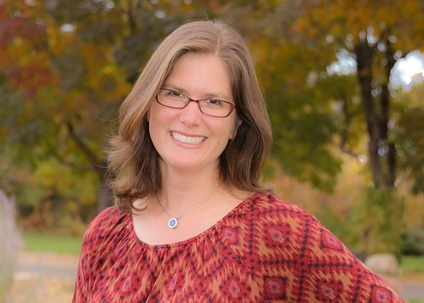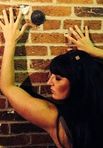Carpe Noctem Book Interview With Emily Pérez
 Center for Literary Publishing, 2016 THINGS WE’RE DYING TO KNOW…
Center for Literary Publishing, 2016 THINGS WE’RE DYING TO KNOW…Let’s start with the book’s title and your cover image. How did you choose each? And, if I asked you to describe or sum up your book, what three words immediately come to mind?
I wanted a title that drew attention to ambivalence about home, family, and domesticity. As this collection evolved, it had three different titles, and it wasn’t until I started writing poems rooted in the “Hansel and Gretel” story, where a house made of sweets is so prominent, that I settled on this title.
I like that both “sugar” and “stone” have diverging connotations. Sugar can be sweetness and promise, or something false and empty, and stone conveys both something steadfast and something cold and impassive.
The cover is the work of my brilliant friend, the artist Jenny Tran. I sent her a group of poems that felt representative of the arc and themes of the book, and then she and I worked together using a common Pinterest account to cultivate a collection of images that we thought resonated with the writing. I'm not a visual person, so I'm lucky Jenny is such a savvy designer. Based on our collection of images, she determined the right balance of darkness and light, nostalgia and modernity. She gave me a few different directions and then pushed further into the one that seemed most productive. I love what she created — its colors, textures, and tiny details, like the shadows cast by the paper house and girl on the green background.
My three word elevator pitch? Families are scary.
What were you trying to achieve with your book? Tell us about the world you were trying to create, and who lives in it.
I wanted to tell the truth, as I perceived it: it is beautiful and terrifying to be a child, and it is beautiful and terrifying to be a parent. Families are a strange amalgam of choice and destiny. They can be both the safest and the most dangerous places to live.
The world I created is one where a fairy tale forest from my childhood imagination blends into the real world settings of my children’s first months on earth. It’s a place where known characters — Red Riding Hood, Gretel, the woodsman’s wife — speak the thoughts of a sleep deprived mother who is trying to determine whether her baby is her greatest love or her greatest enemy. It’s a world where the selfish and selfless collide through the figure of the artist-parent. The world is the past, the present, and the childhood imaginary, all swirled together into thoughts on what it is to be a member of a family and to depend on others.
How did you order the poems in the collection? Do you have a specific method for arranging your poems or is it sort of haphazard, like you lay the pages out on the floor and see what order you pick them back up in?
Perhaps my greatest challenge with this collection was sequencing. I had a very rigid organizational scheme based on the worlds I saw each poem inhabiting: the world of parenting, the world of fairy tales, the world of love and loss, and the world of the past. I knew that the poems in different worlds spoke to each other, and I knew they would do a better job of speaking to each other if they could mingle, but I could not break them out of their sections. Even when I gave myself the task of reordering, at most I would move one or two pieces, and I’d call that a “radical” revision. I was stuck. Finally I enlisted the help of an editor, Susan Kan (of Perugia Press), and asked her to focus specifically on the sequence. She liberated the poems. Though I added some new pieces after the version she saw, the current order is ninety percent her vision, to the point that sometimes I cannot find a particular poem because it’s not where I would have placed it. While I wish I had been able to achieve the structural tension, release, and resonance that she achieved, I am glad that I finally got out of my own way and asked for help.
What do you love to find in a poem you read, or love to craft into a poem you’re writing?
I love to read and write pieces that are musical, where I learn something from the sound as well as from the meaning of the words. I always want to be surprised. To achieve that in my own work, I need to circle around a question I don’t know how to answer; similarly, I am looking for writers who take me down a path where the turns are unexpected.
Can you share an excerpt from your book? And tell us why you chose this poem for us to read – did it galvanize the writing of the rest of the collection? Is it your book’s heart? Is it the first or last poem you wrote for the book?
A New Mother Discovers Emptiness
That winter I resigned my role as hope—
with only two hands, smaller always than I’d needed,
and twice as many yearning mouths to fill.
I concocted stories, songs, and spells,
and once we’d sucked the marrow clean
from words, I spun, I wove, I kept conniving to confect,
but there’s only so much sweetness in the world.
I poured pity on the two of them,
just children still, all their pleasure flown.
In each other’s faces we reflected want,
so I sought solace on my own.
I found it first within the darkness of the woods,
which rendered me invisible. I found it next
within the distance of the stars, whispering how miniscule,
how meaningless my sorrows. Who insists on being heard
when faced with all that space? What is emptiness
when perched upon the lip of a black hole?
I tried to teach those little ones to see,
I pushed them toward the door.
And when they would not go, I locked them out myself.
Here is a pathway, here is bread, I said, you’ll learn
these walls were never real. Make a new home
inside your head. To those who ask me:
What if they are calling in the woods?
I say, at least they’ve learned to sing
and to those who wonder what if
they’re trembling with fear?
I say, then at last they’re full.
Though I didn’t realize it at the time I wrote it, this was the poem in which several themes I’d been exploring coalesced. It helped me understand which poems belonged in my collection and which ones did not.
Though the persona speaking is the woodsman’s wife from “Hansel and Gretel,” she is also the modern mother who is struggling to find the line between her own wants and needs and her children’s. And though this piece primarily empathizes with the mother, I think it also asks the reader to empathize with the cast-aside children.
Are there other types of writing (dictionaries, romance novels, comics, science textbooks, etc.) that help you to write poetry?
Right now, more than other kinds of writing, it’s speech that I find inspiring. I write down stories that my children tell or the way they turn a phrase (for example, my younger son starts many phrases with the word “ever” instead of the word “if” — such as “ever I see a horse…”). Their language helps me see and hear the world in a new way.
What are you working on now?
My sons are becoming increasingly interested in weapons, especially guns. Meanwhile, I'm a high school teacher in a state known for its gun culture; several mass shootings have occurred near where I live and work. My school and my children’s schools practice lock downs. We prepare ourselves for armed intruders. I’m writing now about my children growing up in this culture where they must practice for encounters with violence, as well as the ways I am grappling with their desire to “play” at violence.
What book are you reading that we should also be reading?
You ask Me to Talk About the Interior, by Carolina Ebeid
***
Purchase House of Sugar, House of Stone.
 Emily Pérez is the author of House of Sugar, House of Stone (2016), and the chapbook Backyard Migration Route (2011). She holds degrees from Stanford University and the University of Houston, where she was poetry editor for Gulf Coast and taught with Writers in the Schools. Her poems have appeared or are forthcoming in journals including Poetry, Diode, Bennington Review, Crab Orchard Review, Calyx, Borderlands, and DIAGRAM. She is a high school English teacher and dean in Denver, where she lives with her husband and sons. Visit her online at www.emilyperez.org.
Emily Pérez is the author of House of Sugar, House of Stone (2016), and the chapbook Backyard Migration Route (2011). She holds degrees from Stanford University and the University of Houston, where she was poetry editor for Gulf Coast and taught with Writers in the Schools. Her poems have appeared or are forthcoming in journals including Poetry, Diode, Bennington Review, Crab Orchard Review, Calyx, Borderlands, and DIAGRAM. She is a high school English teacher and dean in Denver, where she lives with her husband and sons. Visit her online at www.emilyperez.org.
Published on October 31, 2016 07:45
No comments have been added yet.



